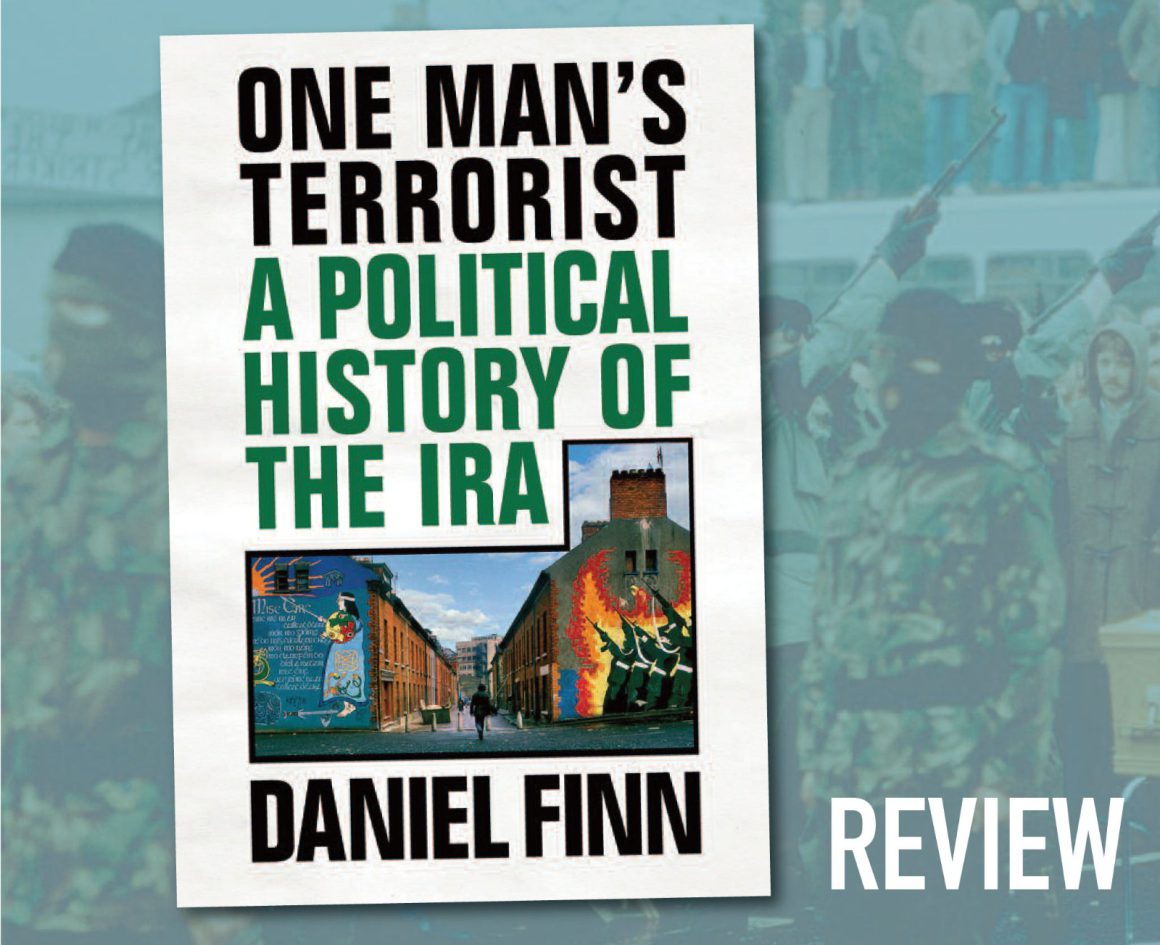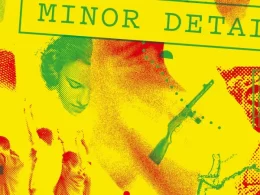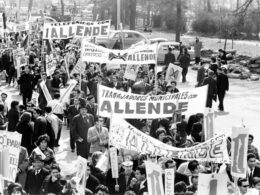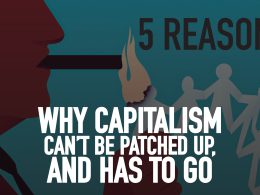Reviewed by Seán Burns
This year marks the 50th anniversary of the formation of the Provisional IRA. This new book, One Man’s Terrorist: A political history of the IRA, is therefore a timely study of this movement. Seán Burns looks at the book and the lessons that can be learned for today.
Napoleon once said, “History is a fable agreed upon”. In Northern Ireland, there is no agreed upon history, or rather there are multiple competing accounts. In nearly all of these, the independent role that the working-class has played is written out. Unfortunately, the author of this book also falls into this trap.
One Man’s Terrorist is an account of the political developments of the Irish republican movement, with a particular focus on the North. The introduction begins with quite harrowing statistics of the death and injury toll during the conflict known as ‘the Troubles’ comparative to the population of Northern Ireland. “Theywere the equivalent of 125,000 deaths and nearly 2 million injuries in Britain”. This immediately puts the scale of the Troubles into perspective. Many workers and young people lost their lives, and tens of thousands were either injured or imprisoned during the conflict. The severe mental strain placed upon the population has yielded an extraordinarily high rate of suicide and mental health problems which continue to express themselves today. More people have died as a result of suicide since the ceasefires than were killed over the course of the conflict.
The divisions which drove the conflict have not been resolved. They continue to largely define the political terrain in Northern Ireland to this day, more than 20 years after the Good Friday Agreement. The ‘ceasefire generation’ got a taste of the reality of paramilitary violence in the killing of Lyra McKee, a young journalist who was shot dead by a ‘dissident’ Republican gunman during a riot in Derry. Her killing sparked widespread anger. Vigils and protests were organised by her friends and family, as well as sections of the trade union movement. The popular sentiment was ‘no going back’ to the days of the widespread violence.
The armed dissident republicans who continue to wage their “war” are, on the whole, marginalised but still able to connect with some of the most hard-pressed sections of Catholic working-class youth, in areas such as the Bogside and Creggan where poverty and unemployment are facts of life. These are the conditions out of which paramilitarism can redevelop if an alternative is not posed. The existence and activities of these groups act as a warning of what can develop if there is no resolution to the national question in Ireland. That is a prospect of renewed conflict and sectarian violence.
But this is, of course, not the 1960s or ‘70s. The basis upon which the Provisional IRA was able to sustain and develop itself has greatly diminished. A power-sharing administration between nationalists and Unionists has replaced Unionist dominance in the devolved government. British soldiers have been effectively withdrawn from the streets. Although disparities remain as a legacy of the past, discrimination against Catholics in access to jobs and homes is largely gone. The Provisional campaign was brought to an end partly because of a growing ‘war weariness’ among the population, given expression by mass protests against sectarian killings and paramilitary activity.
A serious study of Irish republicanism, its armed and political manifestations, is invaluable for socialists and working-class activists to understand the serious limitations and the negative role these ideas and methods have played throughout history. Unfortunately, this is something the author falls short of on a few occasions. The Socialist Party in Ireland bases itself upon the power of the working class and believes that common struggle of working-class people is necessary to change society and end the common misery of sectarian conflict, poverty and oppression that capitalism has to offer us. The forerunner of the Socialist Party, The Militant, at the time consistently opposed the mistaken methods of the IRA and other paramilitary organisations. We argued that the individual terrorist methods of the Provisional IRA were incapable of defeating British imperialism and actually acted to reinforce and increase sectarian division in Northern Ireland.
No stream to swim in
A “fish through the desert” is an aptly named chapter, detailing the isolation that republicanism faced throughout most of the 1950s and 1960s. The attempts of the IRA at the time to wage a “Border Campaign”, where they carried out attacks against police barracks, failed to have any meaningful impact. Likewise, throughout the 1960s, the IRA failed to gain a resonance amongst the population, north or south of the border. This is reflected in the declining membership figures that the author details. However, a question that is not adequately answered in the book is – why was this the case? If the IRA could wage its armed campaign in ‘72, why not in ‘65?
The author, Daniel Finn, identifies some of the reasons. State repression acted as a recruitment sergeant for the IRA. The events of Bloody Sunday in 1972, where British paratroopers gunned down 14 unarmed civil rights protesters in Derry, drove many young Catholics into the arms of the PIRA. They saw in them a vehicle to strike back against the system which meted out acts of brutality and offered them only a future of poverty and unemployment. Throughout the conflict, callous acts of repression by British imperialism would play this role repeatedly.
However a major omission as to why the IRA and other paramilitary forces were unable to gain mass traction throughout most of the 1960s was that working-class people from both Protestant and Catholic backgrounds were beginning to struggle together against the status quo. The author makes some reference to the Northern Ireland Labour Party’s (NILP) electoral success. But he downplays its significance.
The road not taken
In the 1960s, the NILP, for all its weaknesses, had a mass base of support. In 1962, it gained 62,175 votes in Belfast, compared to 67,350 for the Unionist candidates. This represented 26% of the votes cast. The total left-wing vote in Belfast was 32.8%. Even after the violence of August 1969, the NILP retained mass support and achieved 105,759 votes in the 1970 general election.
The author dismisses Labour’s support politically, and also the prospect of united class struggle. He quotes the promises of “a social & economic revolution”from the old Unionist leadership made at the time and states, “that proved enough to avoid the specter of defeat”, before swiftly moving on. He, in essence, articulates the idea that unity was not possible at this point as a result of promises made to Protestant workers. Contrary to what the author presents, the idea that workers could be united both industrially and politically was not utopian but was a living reality at the time. The 1960s saw the Unionist establishment scramble to tackle the rising class struggle and the increasing unity of Catholic and Protestant workers by resorting to sectarian bigotry.
The most remarkable development in the early 1960s was a generalised shift to the left in society. Catholic workers saw the IRA and their methods as offering no coherent alternative to the discrimination and poverty that they faced at the hands of the Unionist establishment. Likewise, Protestant workers were increasingly engaging in strike action against their bosses and looking leftwards. The lords and ladies of official Unionism were quick to take note of these developments. For them, their majority was secure so long as Catholics voted for nationalists and Protestants voted for Unionists. The possibility of the labour movement bridging that sectarian divide posed serious issues for them and they responded to its growth with vitriol.
“Employers should consult the unionist register and pick their employees from it” – this is often quoted as an example of the instrangient sectarianism of the Unionist government, but its real significance is often overlooked. It was made on 5th March 1961, just after titanic strikes of both Catholic and Protestant workers rocked the Belfast shipyard. It is not for no reason that the old Unionist regime at the time scrambled to resurrect the “Unionist Labour Clubs”. These associations were designed to tie together Protestant workers under the banner of Unionism rather than class, in order to disrupt the developing unity between workers. They were not to make much impact, however.
Civil rights struggle explodes
Young people looked elsewhere for methods to struggle. Events internationally would have an explosive effect. The idea that mass struggle was necessary to enact change, as well as the ideas of socialism and class struggle, were being brought to the fore. From the late 1950s, the black civil rights movement convulsed the United States and, in the ‘long hot summer of 1967’, riots rocked dozens of cities as the downtrodden rose up in revolt. The year of 1968 was dominated above all by the May revolutionary “evenements” in France. A general strike of ten million workers demonstrated the power of the working class, and President de Gaulle fled the country, openly voicing his fear that the game was up for capitalism. These events displayed clearly the power of class struggle, strikes and mass movements, and were a source of inspiration for young people and workers in Northern Ireland at the time.
The civil rights movement, although predominantly Catholic, gained an echo among Protestant youth, at least initially. They were inspired by what they were witnessing internationally, and outraged at the conditions of discrimniation and poverty that existed at home. An illustration of the rampant poverty in the 1960s was that nearly 100,000 homes were declared “unfit for human habitation”, spanning both Protestant and Catholic areas.
It was the failure of the labour movement to decisively intervene that allowed the so-called ‘moderates’, such as John Hume, to stamp their authority on the civil rights movement. Hume, a voice for the conservative Catholic middle class, argued vehemently against class or socialist ideas that might ‘split’ his aim of all-class, “Catholic unity.” This watered down the programmatic demands to those simply demanding more rights for Catholics, an equality of poverty, not the broad class demands that had previously been put forward. This allowed the government to paint it as a movement against Protestants and dissuade broad cross-community from developing. Unionist die-hards such as Paisley were an isolated minority through most of the 1960s, viewed as a rabid fringe element by the majority of Protestant workers. As the civil rights movement became increasingly framed in terms of Catholic rather than class unity, however, they were able to begin to make strides forward.
Likewise, the conservative heads of the NILP and the trade union movement stood aside during the stormy events of 1969. The trade union leadership, heading a 210,000 strong movement of both Catholic and Protestant workers, sat aloof from the turmoil – through months of demonstrations, counter-demonstrations, riots and mounting tension – restricting themselves to praising the Unionist government for the partial reforms that were forced upon them and to issuing sanctimonious pleas for calm.
If they had instead launched a struggle for civil rIghts, decent jobs and housing for all working-class people, as well as challenging the repression being meted out by the Unionist establishment, a united working-class opposition could have been built.
Splits in republicanism
It was in the context of these huge upheavals that leading members of the Southern establishment, including future Taoiseach Charles Haughey, sought to intervene into the situation to protect capitalism’s interests. They were terrified of what was developing behind the barricades in Northern Ireland, with new organisations being thrown up that they had little to no influence over and socialist ideas spreading. Their ‘assistance’ was aimed at buying organisational and political influence so as to limit the movement in the North by harnessing it safely in the halter of Catholic sectarianism and nationalism
They offered £100,000 to supply weapons to the IRA but firm conditions were attached. These were that the ‘socialist’ policies of the IRA should be dropped, that there should be a separate Northern command structure for the IRA , and that all IRA military activity be confined to the North.
The first issue of An Phoblacht sums up the politics of the new Provisional leadership:
“Gradually into executive positions, both in the IRA and Sinn Fein, the Red Agents infiltrated and soon these men became the policymakers. Young men and girls were brainwashed with the teachings and propaganda of the new policymakers and well trained organisers were sent into different areas to spread the teachings of these Red Infiltrators”.
It is worth spending some time considering the debates that developed over political programme. The split between the ‘Provos’ and Officials was not just, as the author succinctly puts it, between “soldiers” and “politicians”. But the author does warn against “reading too much” into the “finer details”, ie the politics, and quotes Kieran Conway in saying that it was not the first concern for many IRA volunteers. There is quite clearly a certain truth in this, insofar as it is unquestionable that, in the stormy events of the late 1960s and early ‘70s, action spoke louder than words, particularly for a new generation dubbeds the 69ers. However, the split in the IRA and the political debate that emerged were not insignificant and have lasting effects to this day.
Contrary to what the newly founded Provisional leadership would argue, Johnston and Goulding – who went on to become leading members of the Officials – were not advocating the dropping of nationalism for socialism. Nor were they pushing for a genuine turn to the left. As the author suggests, “If Johnston had wanted to guide republicans further to the left then he was pushing at an open door”.Their programme was reminiscent of the Stalinist position of the 1930s, proposing an all-class “anti-imperialist” alliance. History here and elsewhere has demonstrated that the working-class is subordinated in such alliances to the interests of the capitalist and middle class leaders. The reality of this programme was played out in the civil rights movement, the potential of which was scuppered by nationalist leaders like Hume.
This programme, and variants of it, would be utilised by the Provisionals as well at various stages. It presented the struggle for socialism in stages. That first you fight for Irish unity on the basis of capitalism, then for socialism. This inevitably meant that the question of class was pushed beneath the national struggle in a futile attempt to unite exploiter and exploited.
Such a formula crashed against the rocks of sectarianism. For Protestant workers, the prospect of capitalist unification with an economically and socially backward Southern state in which they feared being an oppressed minority was a complete anathema. The adoption of left-sounding rhetoric by the Provisionals would damage the name of socialism by associating it with the armed campaign of the Provos in the minds of working-class Protestants.
“The Great Moment”
“Individual terrorism” is the Marxist term for the tactic of assassinating representatives of the ruling class or of the state forces, employed by secretive armed groups. In place of mass action by the working class, these groups substitute their deeds. The working class is expected to provide support, but otherwise simply observe the struggle. Individual terrorism has never succeeded in defeating a modern capitalist government anywhere.
Trotsky’s writings on individual terror are quite prophetic in this regard: “By its very essence terrorist work demands such concentrated energy for “the great moment,” such an overestimation of the significance of individual heroism, and finally, such a “hermetic” conspiracy, that – if not logically, then psychologically – it totally excludes agitational and organisational work among the masses.”
The “great moment” for the Provos was always one more push to achieve British withdrawal. This mantra, repeated for 20 years, was never fulfilled. The Provos could never militarily defeat the British state and, conversely, the British state could not militarily quash the Provisionals. It was recognition that the IRA campaign could not succeed – and also recognition that the Protestant population, rather than the British, were the main barrier to a united Ireland – that forced the republican leadership to try to find another road.
Armed campaign rife with contradictions
Today, a more romanticised view of the Provisional campaign is presented – that of gallant volunteers with the mass of the Catholic population behind them. Reality is more complicated. The blatant contradiction in the IRA campaign was that its greatest military successes were also its greatest political failures. Successfully carrying out bombings and shootings, particuarly when there where civilian casualties, provoked a backlash from both Catholic and Protestant workers – for example, the Enniskillen bombing, which killed 11 civilians on Remembrance Sunday. It was when British imperialism came down in a heavy-handed manner, meting out acts of brutality and repression, that the Provisionals gained sympathy and support. This was most epitomised in the callous role of Thatcher during the 1981 hunger strikes.
The terror tactics employed by the PIRA also had the opposite effect to that intended so far as a challenge to the state was concerned. Far from weakening the British state, they gave it space and an excuse to introduce increasingly repressive measures and for those measures to become normalised. The use of diplock courts, plastic bullets and live ammunition all became norms in Northern Ireland. In Britain, when the miners sought to take on Thatcher through their strike action in the 1980s, repressive policing methods perfected in Belfast were used against mining communities.
“One man’s terrorist”
The IRA’s support amounted to only a minority of the Catholic minority and, whatever the IRA’s stated intention, the objective result of its armed campaign was to stoke the flames of sectarianism, increasing divisions amongst Catholic and Protestant workers, and to vastly reduce any prospect of its stated aim of “British withdrawal”.
The sectarian edge to the Provisional campaign was not immediately obvious when they attacked soldiers and other members of the state’s repressive apparatus. The author illustrates a more naked expression of sectarianism emanating from the heads of the Provisionals leadership when he quotes Seán Mac Stifoian on the question of Protestant opposition post-united Ireland: “There would be no place for those who say they want their British heritage. They’ve got to accept their Irish heritage… otherwise there would be no place for them”.
Their fundamental method was sectarian in nature. They ignored the views and aspirations of Protestants. This same dismissiveness reflects itself today in the debates around a border poll. While they speak of reaching out to the Protestant community, the underlying reality of the position of Sinn Féin today is that, like it or lump it, capitalist unity is inevitable. They have no qualms that by a simple majority, one community can be coerced into a state they have no desire to be a part of. This displays a profound amnesia on their part. Catholics did not, and will not, abandon their aspiration for reunification even when they were a minority for decades. Neither will Protestants abandon their opposition to a united Ireland if they become a minority within the Northern state. A majority at the ballot box does not eradicate the clash of aspirations and identities that is present in the North.
It was hard to disguise this sectarian edge when car bombs destroyed the centres of largely Protestant towns. At other times, the Provos campaign was nakedly and viciously sectarian – for example, in the period of 1975-76, more than 60 Protestant civilians died in sectarian attacks.
Even when the actions of IRA volunteers were not intentionally sectarian, the campaign as a whole was objectively sectarian and acted to deepen division rather than break it down. The author references this reality, “To a large extent the Provos were fighting a war of attrition against the Protestant community in arms”. The “Ulsterisation” of the security forces compounded this. Even when members of the state forces, such as UDR soldiers, were targeted, this was viewed as an attack upon the Protestant community and drove them further into the hands of the state.
Likewise, their bombing campaign against commercial targets – such as Bloody Friday, when the PIRA detonated 20 bombs in the space of eight minutes in Belfast city center, killing nine people, including five civilians – drove young Protestants into the hands of loyalist paramilitaries. Former PUP leader David Irvine explained that he joined the UVF in the aftermath of these bombings, and thousands joined the UDA and UFF.
The forerunner of the Socialist Party at the time, in an article written by Peter Hadden, warned what the reality of these methods meant: “The IRA does have a military capacity – not to shift or drive out the British – but to stir up sectarian reaction in Northern Ireland. The fear created by the Canary Wharf bomb (in London)has not been fear of a new and effective “anti-imperialist struggle” by the IRA, but fear that any new campaign could push Northern Ireland over the precipice towards all-out sectarian conflict.”
Nationalism & Socialists
Marxists are the utmost defenders of democratic rights. This does not mean, as some on the left crudely present, solely the rights of Catholic workers. We defend the democratic and national rights of all communities on this island. Any attempt to coerce any community into an arrangement which they do not consent to is a recipe for sectarian conflict and ultimately – unless the working class unites in a struggle for socialism – civil war. The history of partition is testament to that.
Socialists base ourselves on the fundamental unity of the working class in the unions, workplaces and in struggles. We campaign to give this unity political expression, campaigning for the building of a mass anti-sectarian party of the working class. We advocate a socialist Ireland – with full and equal rights for all communities, including the protection of minorities – in a voluntary socialist federation with a socialist Scotland, Wales & England.
Unfortunately, throughout much of the book, the author downplays the role of the working-class and the effect of class struggle upon the republican movement and society more generally. While ultimately concluding that the armed campaign was a failure, and commenting upon the effect that it had in intensifying sectarian divisions in the North, the author does not grapple with the sectarian logic of the campaign in ignoring and dismissing the views and aspirations of the Protestant community. Despite these limitations, One Man’s Terrorist provides quite a detailed and comprehensive account of the republican movement that is worth reading.
- Review: One Man’s Terrorist by Dan Finn Dan Finn, One Man’s Terrorist(Verso 2020) pg.1
- One Man’s Terrorist, pg 38
- Peter Hadden,Common History Common Struggle
- One Man’s Terrorist, pg 38
- One Man’s Terrorist, pg 73
- Leon Trotsky, The Bankruptcy of Individual Terrorism, 1909
- One Man’s Terrorist,pg 171
- Peter Hadden, Has Republicanism reached an impasse?, March 1996












